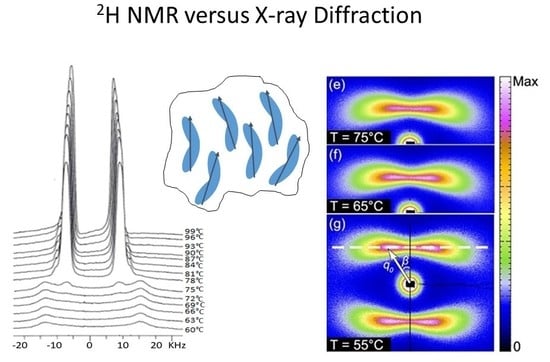Comparative 2H NMR and X-Ray Diffraction Investigation of a Bent-Core Liquid Crystal Showing a Nematic Phase
Abstract
1. Introduction
2. Materials and Methods
2.1. Liquid Crystalline Sample and Mesomorphic Characterization
2.2. H NMR Measurements
2.3. XRD Measurements
3. Results and Discussion
3.1. 2H NMR Results
3.2. X-ray Diffraction Results
3.3. Structure and Orientation: Final Discussion
4. Conclusions
Author Contributions
Funding
Acknowledgments
Conflicts of Interest
References
- Niori, T.; Sekine, F.; Watanabe, J.; Furukawa, T.; Takezoe, H.J. Distinct ferroelectric smectic liquid crystals consisting of banana shaped achiral molecules. J. Mater. Chem. 1996, 7, 1231. [Google Scholar] [CrossRef]
- Harkins, R.; Tauscher, T.; Nguyen, J. Biaxial ordering in the supercooled nematic phase of bent-core mesogens: Effects of molecular symmetry and outer wing lateral groups. Liq. Cryst. 2019. [Google Scholar] [CrossRef]
- Begum, N.; Kaur, S.; Mohiuddin, G.; Nandi, R.; Gupta, S.P.; Rao, N.V.S.; Pal, S.K. Structural understanding, photoswitchability, and supergelation of a new class of four ring-based bent-shaped liquid crystal. J. Phys. Chem. B 2019, 123, 4443–4451. [Google Scholar] [CrossRef] [PubMed]
- Alaasar, M.; Prehm, M.; Belau, S.; Sebastian, N.; Kurachkina, M.; Eremin, A.; Chen, C.L.; Liu, F.; Tschierske, C. Polar order, mirror symmetry breaking, and photoswitching of chirality and polarity in functional bent-core mesogens. Chem. A Eur. J. 2019, 25, 6362–6377. [Google Scholar] [CrossRef]
- Pelzl, G.; Diele, S.; Weissflog, W. Banana-shaped compounds–A new field of liquid crystals. Adv. Mater. 1999, 11, 707. [Google Scholar] [CrossRef]
- Eremin, A.; Jakli, A. Polar bent-shape liquid crystals–From molecular bend to layer splay and chirality. Soft Matter 2013, 9, 615–637. [Google Scholar] [CrossRef]
- Lin, S.C.; Ho, R.M.; Chang, C.Y.; Hsu, C.S. Hierarchical superstructures with control of helicity from the self-assembly of chiral bent-core molecules. Chem. A Eur. J. 2012, 18, 9091–9098. [Google Scholar] [CrossRef]
- Vita, F.; Adamo, F.C.; Francescangeli, O. Polar order in bent-core nematics: An overview. J. Mol. Liq. 2018, 267, 564–573. [Google Scholar] [CrossRef]
- Acharya, B.R.; Primak, A.; Kumar, S. Biaxial nematic phase in bent-core thermotropic mesogens. Phys. Rev. Lett. 2004, 92, 145506. [Google Scholar] [CrossRef]
- Madsen, L.A.; Dingemans, T.J.; Nakata, M.; Samulski, E.T. Thermotropic biaxial nematic liquid crystals. Phys. Rev. Lett. 2004, 92, 145505. [Google Scholar] [CrossRef]
- Vita, F. Search for nematic biaxiality in bent-core mesogens: An X-ray diffraction perspective. Liq. Cryst. 2016, 43, 2254–2276. [Google Scholar] [CrossRef]
- Francescangeli, O.; Stanic, V.; Torgova, S.I.; Strigazzi, A.; Scaramuzza, N.; Ferrero, C.; Dolbnya, I.P.; Weiss, T.M.; Berardi, R.; Muccioli, L.; et al. Ferroelectric response and induced biaxiality in the nematic phase of a bent-core mesogen. Adv. Funct. Mater. 2009, 19, 2592–2600. [Google Scholar] [CrossRef]
- Francescangeli, O.; Vita, F.; Fauth, F.; Samulski, E.T. Extraordinary magnetic field effect in bent-core liquid crystals. Phys. Rev. Lett. 2011, 107, 207801. [Google Scholar] [CrossRef] [PubMed]
- Gleeson, H.F.; Kaur, S.; Görtz, V.; Belaissaoui, A.; Cowling, S.; Goodby, J.W. The nematic phases of bent-core liquid crystals. ChemPhysChem 2014, 15, 1251–1260. [Google Scholar] [CrossRef]
- Francescangeli, O.; Vita, F.; Samulski, E.T. The cybotactic nematic phase of bent-core mesogens: State of the art and future developments. Soft Matter 2014, 10, 7685–7691. [Google Scholar] [CrossRef]
- Francescangeli, O.; Vita, F.; Ferrero, C.; Dingemans, T.; Samulski, E.T. Cybotaxis dominates the nematic phase of bent-core mesogens: A small-angle diffuse X-ray diffraction study. Soft Matter 2011, 7, 895–901. [Google Scholar] [CrossRef]
- Francescangeli, O.; Samulski, E.T. Insights into the cybotactic nematic phase of bent-core molecules. Soft Matter 2010, 6, 2413–2420. [Google Scholar] [CrossRef]
- Kim, Y.-K.; Cukrov, G.; Vita, F.; Scharrer, E.; Samulski, E.T.; Francescangeli, O.; Lavrentovich, O.D. Search for microscopic and macroscopic biaxiality in the cybotactic nematic phase of new oxadiazole bent-core mesogens. Phys. Rev. E 2016, 93, 062701. [Google Scholar] [CrossRef]
- De Vries, A. Evidence for the existence of more than one type of nematic phase. Mol. Cryst. Liq. Cryst. 1970, 10, 31–37. [Google Scholar] [CrossRef]
- Stojadinovic, S.; Adorjan, A.; Sprunt, S.; Sawade, H.; Jakli, A. Dynamics of the nematic phase of a bent-core liquid crystal. Phys. Rev. E Stat. Nonlinear Soft Matter Phys. 2002, 66, 060701. [Google Scholar] [CrossRef]
- Domenici, V.; Geppi, M.; Veracini, C.A.; Blinc, R.; Lebar, A.; Zalar, B. Unusual dynamic behavior in the isotropic phase of banana mesogens detected by H-2 NMR line width and T-2 measurements. J. Phys. Chem. B 2005, 109, 769–774. [Google Scholar] [CrossRef] [PubMed]
- Domenici, V.; Veracini, C.A.; Zalar, B. How do banana-shaped molecules get oriented (if they do) in the magnetic field? Soft Matter 2005, 1, 408–411. [Google Scholar] [CrossRef]
- Domenici, V.; Veracini, C.A.; Fodor-Csorba, K.; Prampolini, G.; Cacelli, I.; Lebar, A.; Zalar, B. Banana-shaped molecules peculiarly oriented in a magnetic field: H-2 NMR spectroscopy and quantum mechanical calculations. ChemPhysChem 2007, 8, 2321–2330. [Google Scholar] [CrossRef] [PubMed]
- Domenici, V. Dynamics in the isotropic and nematic phases of bent-core liquid crystals: NMR perspectives. Soft Matter 2011, 7, 1589–1598. [Google Scholar] [CrossRef]
- Domenici, V.; Fodor-Csorba, K.; Frezzato, D.; Moro, G.; Veracini, C.A. Deuterium NMR evidences of slow dynamics in the nematic phase of a banana-shaped liquid crystal. Ferroelectrics 2006, 344, 263–272. [Google Scholar] [CrossRef]
- Domenici, V.; Apih, T.; Veracini, C.A. Molecular motions of banana-shaped liquid crystals studied by NMR spectroscopy. Thin Solid Films 2008, 517, 1402–1406. [Google Scholar] [CrossRef]
- Cifelli, M.; Domenici, V. NMR investigation of the dynamics of banana shaped molecules in the isotropic phase: A comparison with calamitic mesogens behaviour. Phys. Chem. Chem. Phys. 2007, 9, 1202–1209. [Google Scholar] [CrossRef]
- Domenici, V.; Madsen, L.A.; Choi, E.J.; Samulski, E.T.; Veracini, C.A. Investigating the core moiety of banana-shaped liquid crystals using H-2 NMR coupled with quantum simulations. Chem. Phys. Lett. 2005, 402, 318–323. [Google Scholar] [CrossRef]
- Cinacchi, G.; Domenici, V. Orientational ordering of a banana-shaped solute molecule in a nematic calamitic solvent by H-2-NMR spectroscopy: An indication of glasslike behavior. Phys. Rev. E 2006, 74, 030701. [Google Scholar] [CrossRef]
- Domenici, V. Order and dynamics of rod-like and banana-shaped liquid crystals by H-2 NMR. Pure Appl. Chem. 2007, 79, 21–37. [Google Scholar] [CrossRef]
- Cifelli, M.; Domenici, V.; Veracini, C.A. Recent advancements in understanding thermotropic liquid crystal structure and dynamics by means of NMR spectroscopy. Curr. Opin. Colloid Interface Sci. 2013, 18, 190–200. [Google Scholar] [CrossRef]
- Figueirinhas, J.L.; Dong, R.Y. NMR of bent-core nematogens: A mini-review. Magn. Reson. Chem. 2014, 52, 614–624. [Google Scholar] [CrossRef] [PubMed]
- Dong, R.Y. Recent developments in biaxial liquid crystals: An NMR perspective. Int. J. Mod. Phys. B 2010, 24, 4641–4682. [Google Scholar] [CrossRef]
- Domenici, V. A brief overview of 2H NMR experiments used to study the phase biaxiality in nematic liquid crystals. Mol. Cryst. Liq. Cryst. 2012, 558, 37–45. [Google Scholar] [CrossRef]
- Cruz, C.; Figueirinhas, J.L.; Filip, D.; Feio, G.; Ribeiro, A.C.; Frère, Y.; Meyer, T.; Mehl, G.H. Biaxial nematic order and phase behavior studies in an organosiloxane tetrapode using complementary deuterium NMR experiments. Phys. Rev. E 2008, 78, 051702. [Google Scholar] [CrossRef]
- Fodor-Csorba, K.; Vajda, A.; Jákli, A.; Slugovc, C.; Trimmel, G.; Demus, D.; Gács-Baitz, E.; Holly, S.; Galli, G. Ester type banana-shaped liquid crystalline monomers: Synthesis and physical properties. J. Mater. Chem. 2004, 14, 2499–2506. [Google Scholar] [CrossRef]
- Xu, J.; Fodor-Csorba, K.; Dong, R.Y. Orientational ordering of a bent-core mesogen by two-dimensional 13C NMR spectroscopy. J. Phys. Chem. A 2005, 109, 1998–2005. [Google Scholar] [CrossRef]
- Dong, R.Y. A comparative 13C NMR study of local ordering in a homologous series of bent-core liquid crystals. J. Phys. Chem. B 2009, 113, 1933–1939. [Google Scholar] [CrossRef]
- Dong, R.Y.; Zhang, J.; Fodor-Csorba, K. On the carbon-13 chemical shift tensors of bent-core mesogens. Chem. Phys. Lett. 2006, 417, 475–479. [Google Scholar] [CrossRef]
- Prampolini, G.; (C.N.R., Pisa, Italy). Personal communication, 2006.
- Ghilardi, M. Studio Chimico Fisico di Un Cristallo Liquido Banana-Shaped in Fase Nematica Cibotattica. Ph.D. Thesis, University of Pisa, Pisa, Italy, 2015. [Google Scholar]
- Thompson, P.B.J.; Bouchenoire, L.; Brown, S.D. New developments at the XMaS beamline for magnetic and high resolution diffraction. AIP Conf. Proc. 2004, 705, 428–431. [Google Scholar] [CrossRef]
- Dong, R.Y. Nuclear Magnetic Resonance of Liquid Crystals; Springer: New York, NY, USA, 1997; ISBN 978-1-4612-1954-5. [Google Scholar]
- Dong, R.Y. Advances in NMR studies of liquid crystals. Annu. Rep. NMR Spectrosc. 2004, 53, 68. [Google Scholar]
- Xu, J.D.; Dong, R.Y.; Domenici, V.; Fodor-Csorba, K.; Veracini, C.A. C-13 and H-2 NMR study of structure and dynamics in banana B-2 phase of a bent-core mesogen. J. Phys. Chem. B 2006, 110, 9434–9441. [Google Scholar] [CrossRef] [PubMed]
- Veracini, C.A. NMR spectra in liquid crystals. In NATO ASI Series, Series C, 141; Emsley, J.W., Ed.; Reidel: Dordrecht, The Netherlands, 1985; Chapter 5. [Google Scholar]
- Vita, F.; Tauscher, T.; Speetjens, F.; Samulski, E.T.; Scharrer, E.; Francescangeli, O. Evidence of biaxial order in the cybotactic nematic phase of bent-core mesogens. Chem. Mater. 2014, 26, 4671–4674. [Google Scholar] [CrossRef]
- Nguyen, J.; Wonderly, W.; Tauscher, T.; Harkins, R.; Vita, F.; Portale, G.; Francescangeli, O.; Samulski, E.T.; Scharrer, E. The effects of lateral halogen substituents on the low-temperature cybotactic nematic phase in oxadiazole based bent-core liquid crystals. Liq. Cryst. 2015, 42, 1754–1764. [Google Scholar] [CrossRef]
- Glebowska, A.; Vita, F.; Francescangeli, O.; Dingemans, T.; Samulski, E. Molecular engineering room-temperature bent-core nematics. Liq. Cryst. 2015, 42, 829–839. [Google Scholar] [CrossRef]
- Vita, F.; Hegde, M.; Portale, G.; Bras, W.; Ferrero, C.; Samulski, E.T.; Francescangeli, O.; Dingemans, T. Molecular ordering in the high-temperature nematic phase of an all-aromatic liquid crystal. Soft Matter 2016, 12, 2309. [Google Scholar] [CrossRef]
- Agra-Kooijman, D.M.; Fisch, M.R.; Kumar, S. The integrals determining orientational order in liquid crystals by x-ray diffraction revisited. Liq. Cryst. 2017, 45, 680–686. [Google Scholar] [CrossRef]
- Sims, M.T.; Abbott, L.C.; Richardson, R.M.; Goodby, J.W.; Moore, J.N. Considerations in the determination of orientational order parameters from X-ray scattering experiments. Liq. Cryst. 2019, 46, 11–24. [Google Scholar] [CrossRef]
- Vita, F.; Adamo, F.C.; Pisani, M.; Heist, L.M.; Li, M.; Hegde, M.; Dingemans, T.J.; Samulski, E.T.; Francescangeli, O. Liquid crystal thermosets. A new class of high-performance materials. Liq. Cryst. 2019. [Google Scholar] [CrossRef]

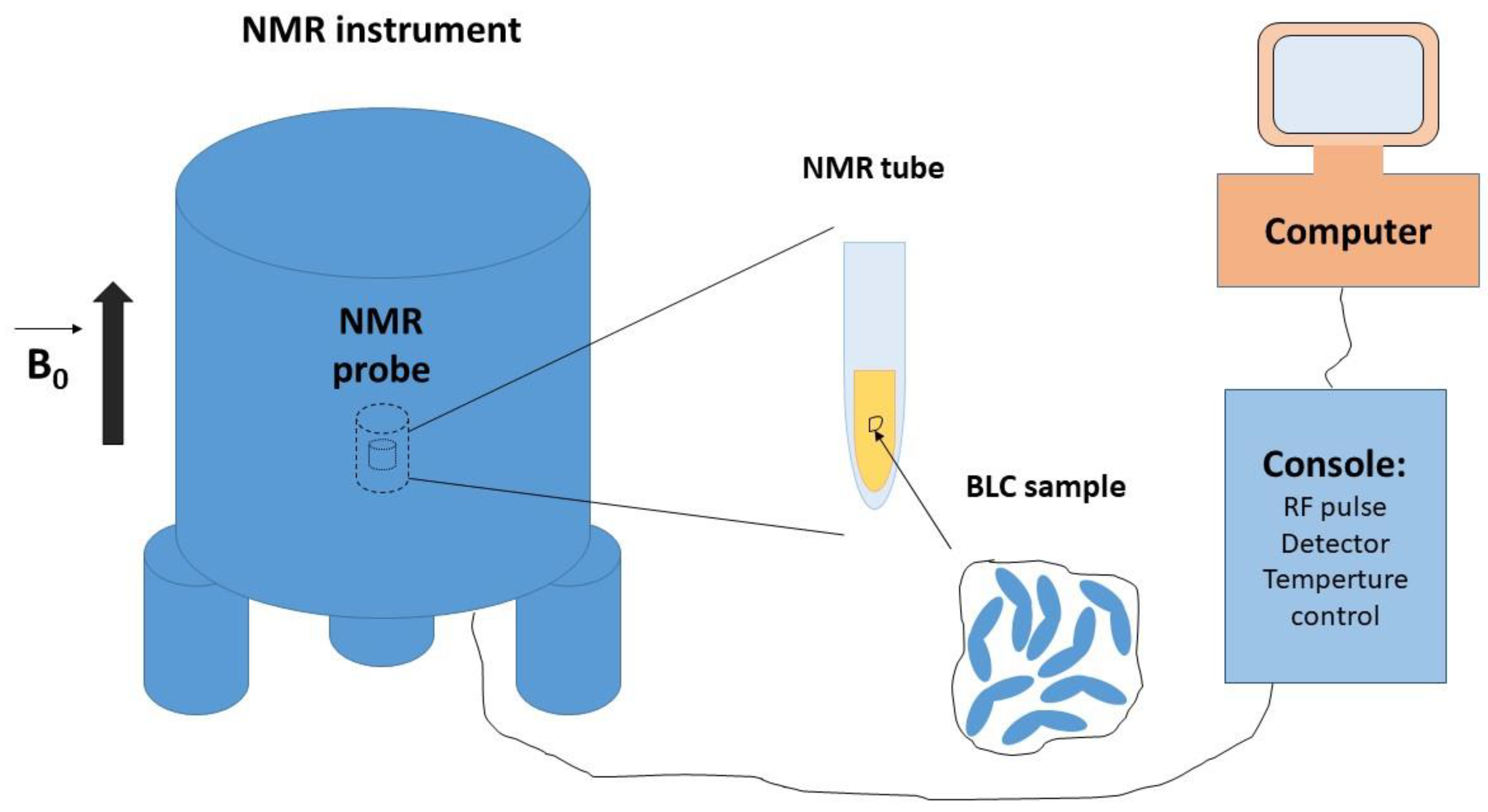
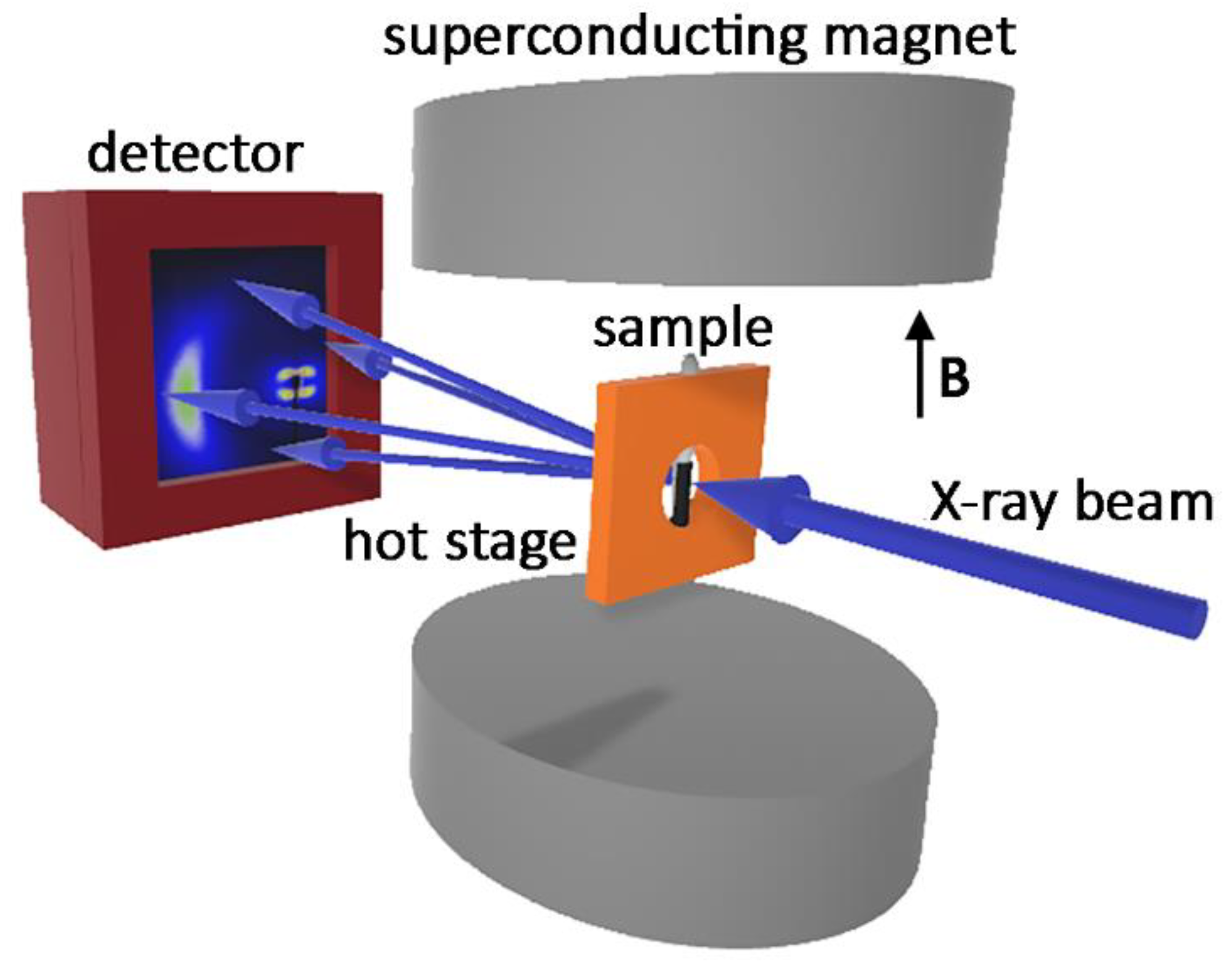
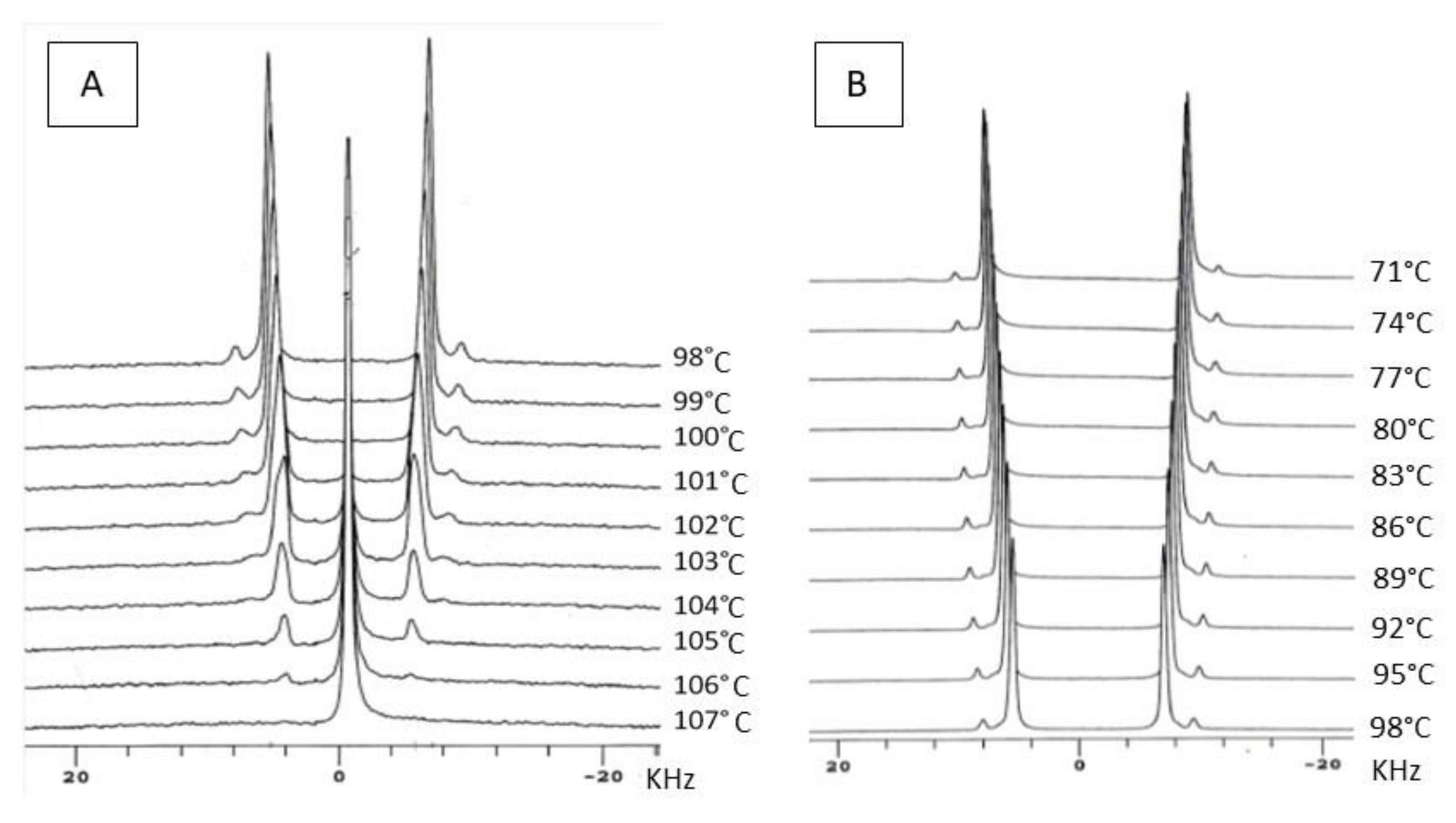
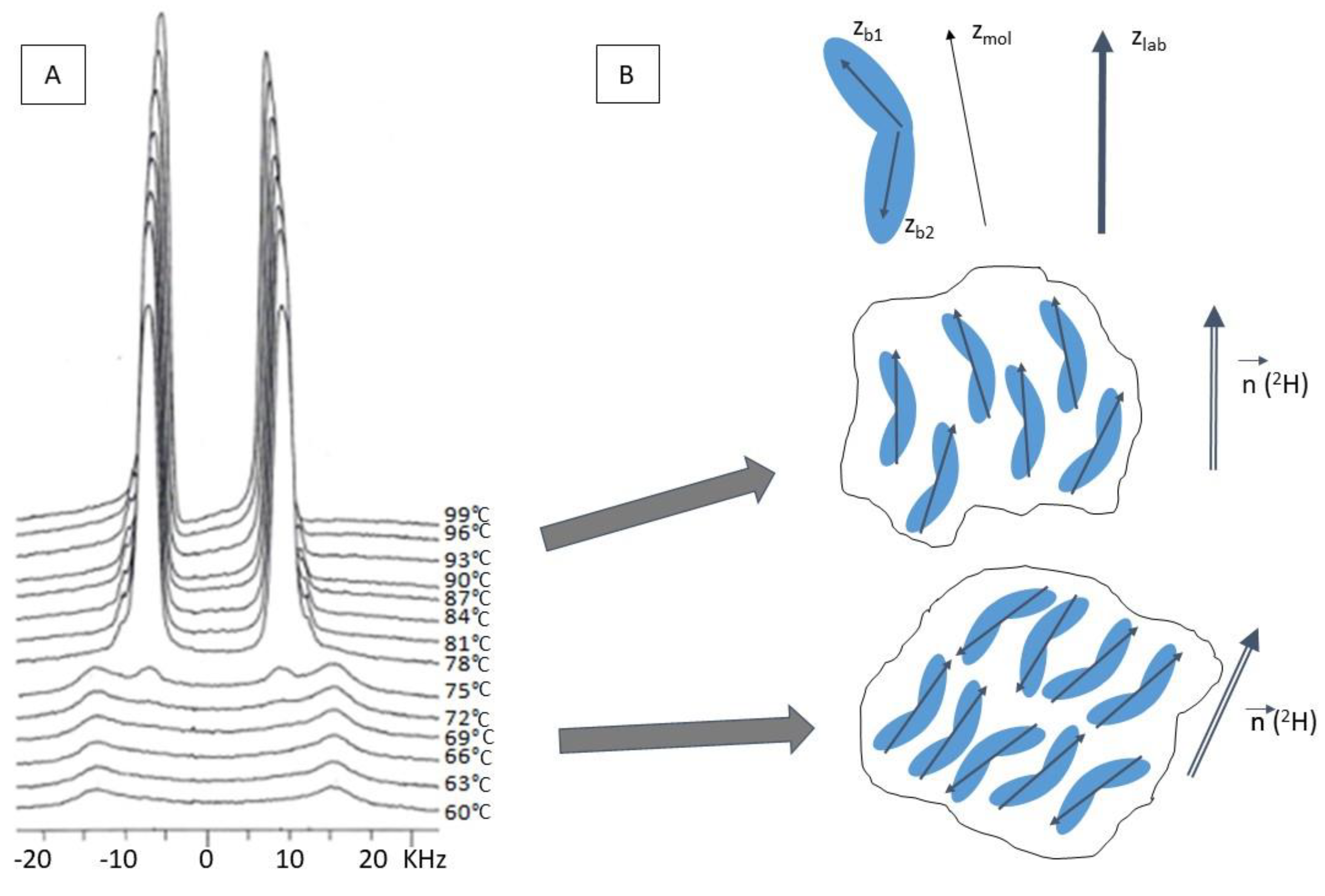
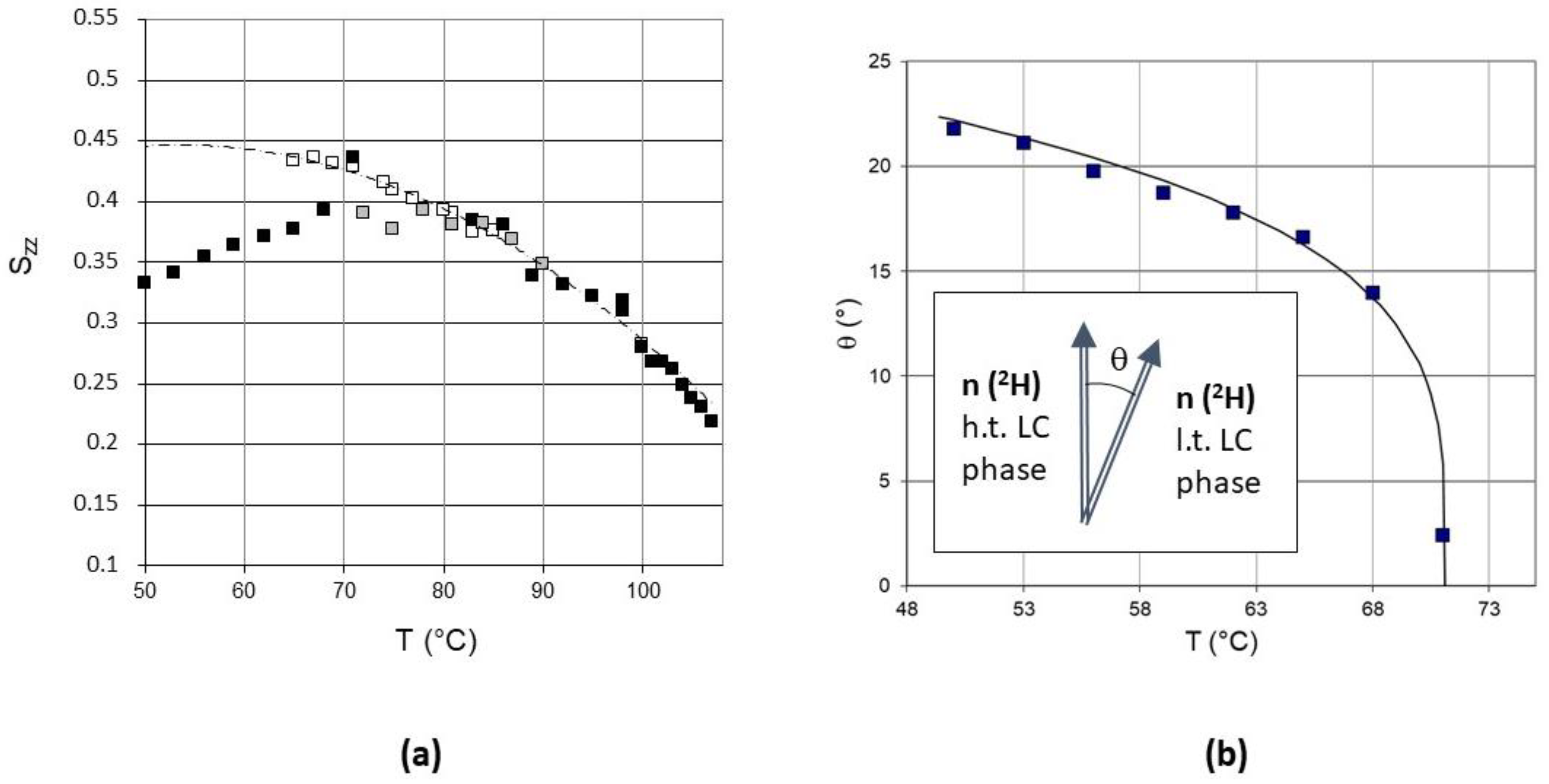
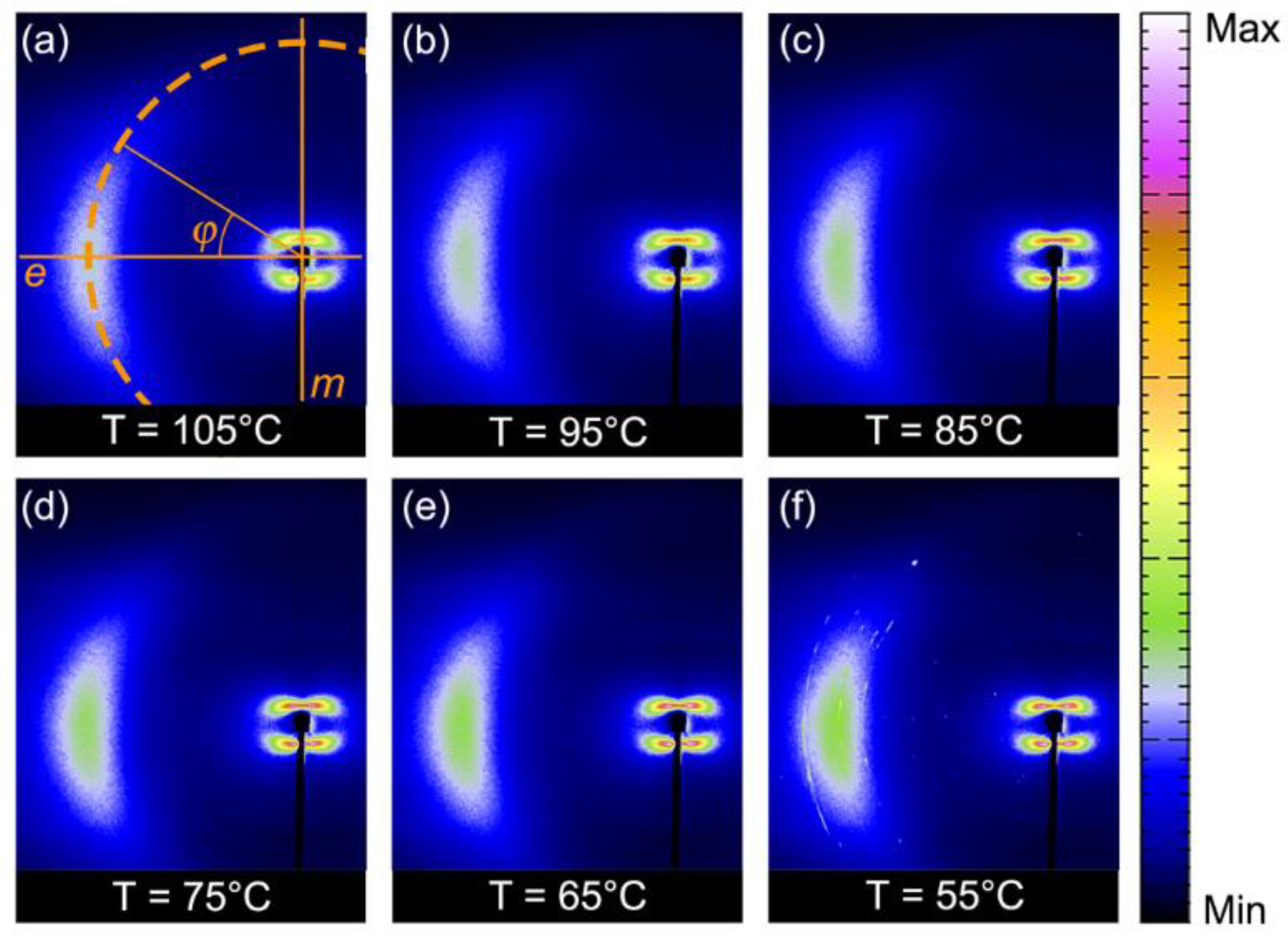
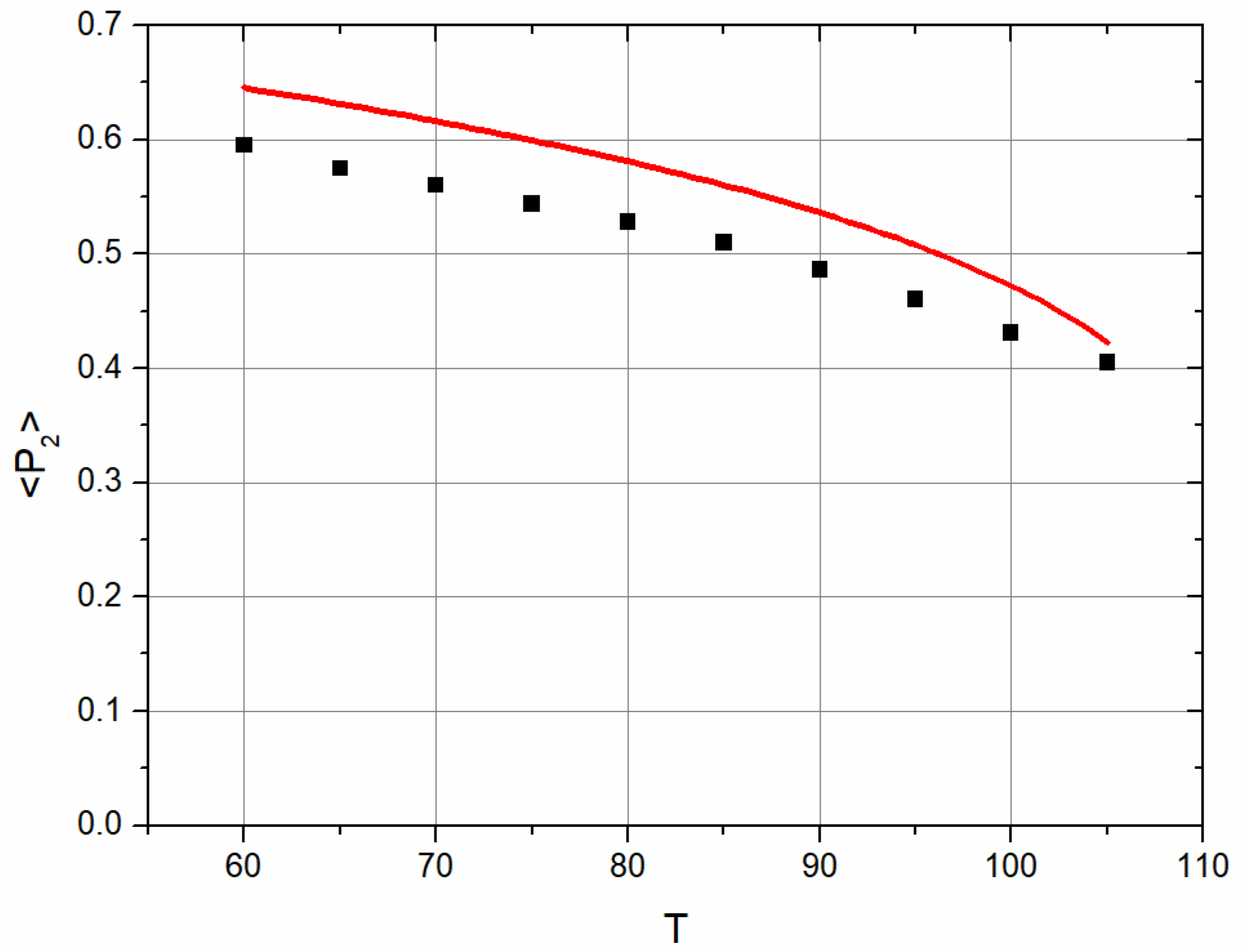

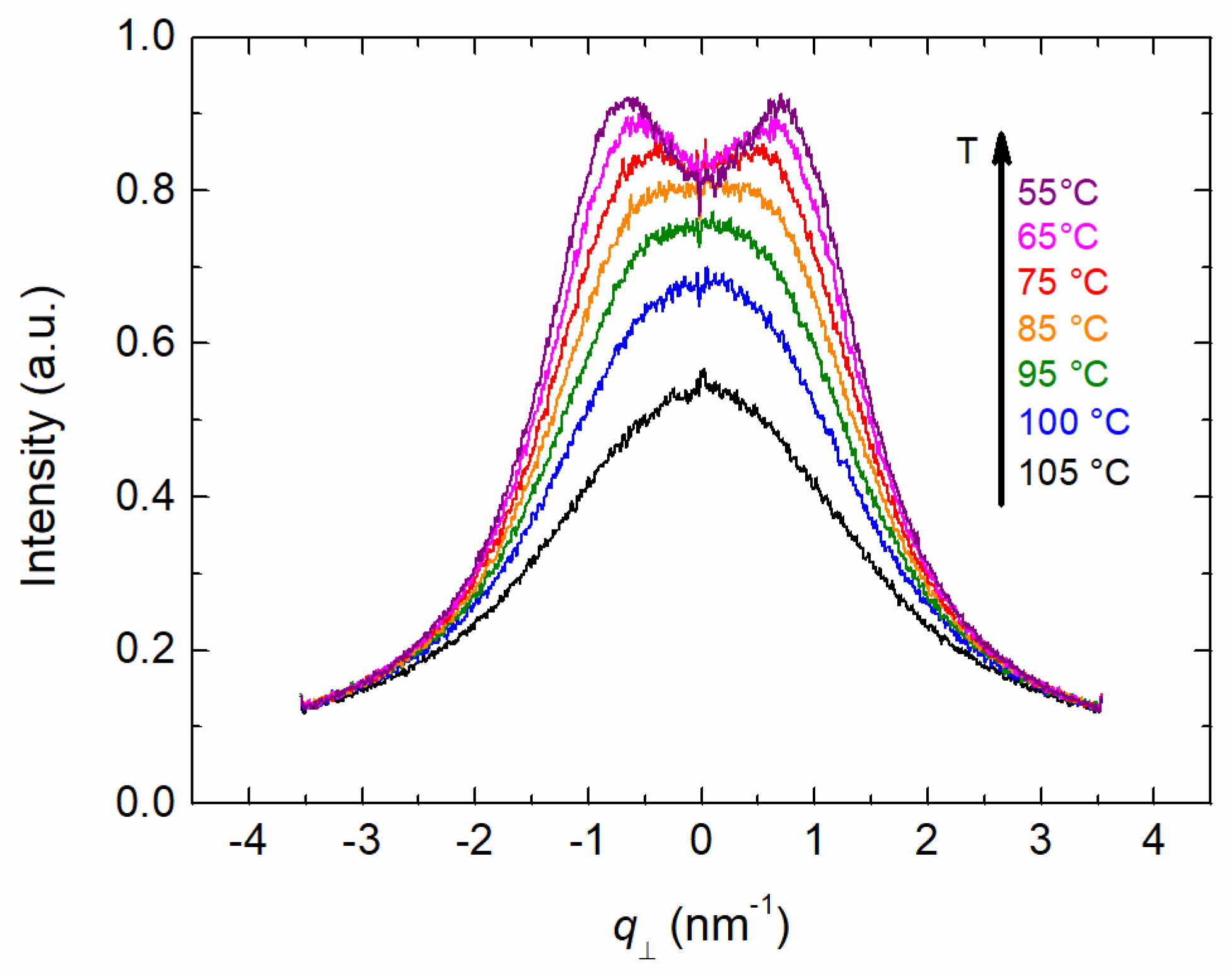
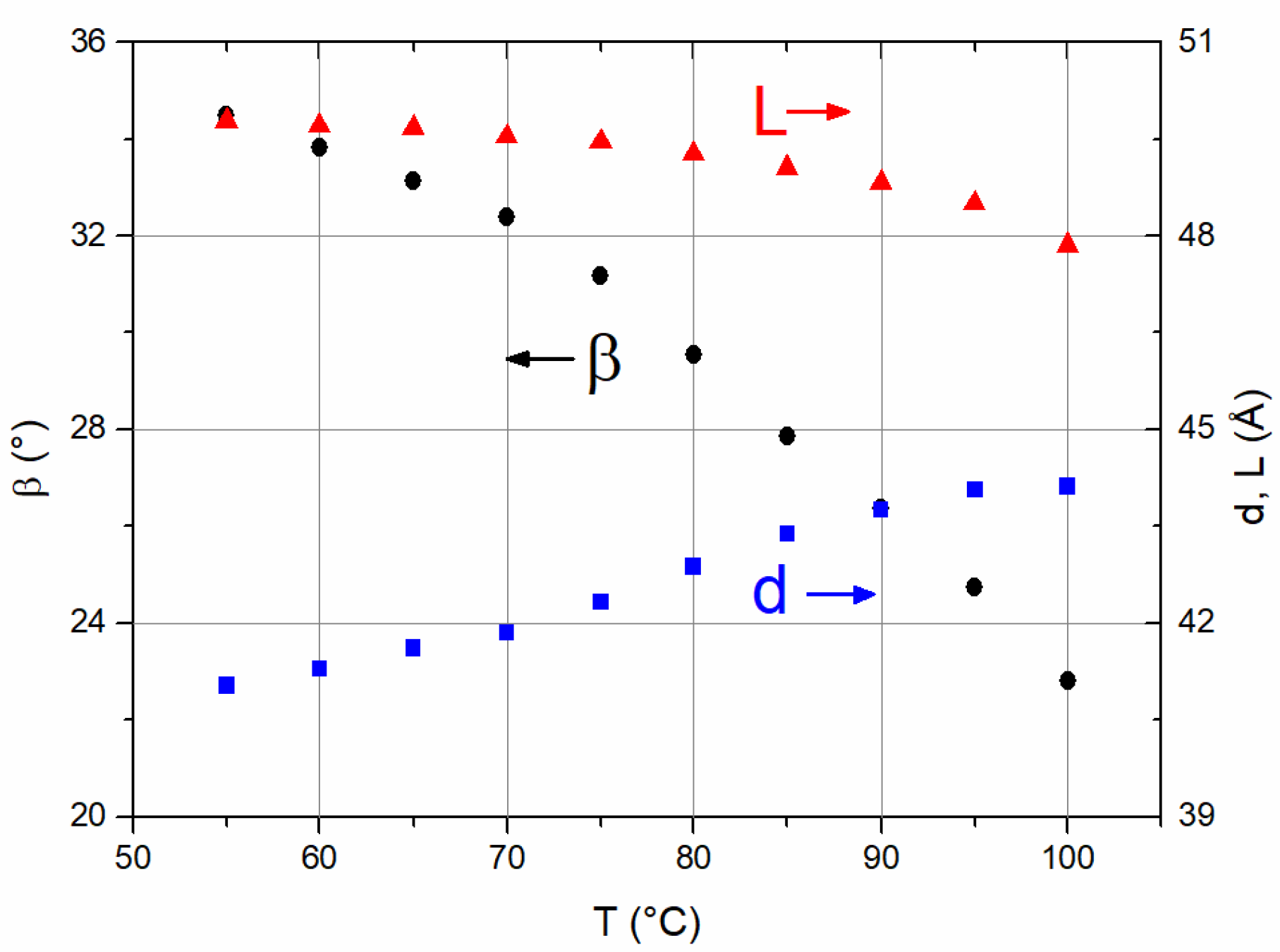
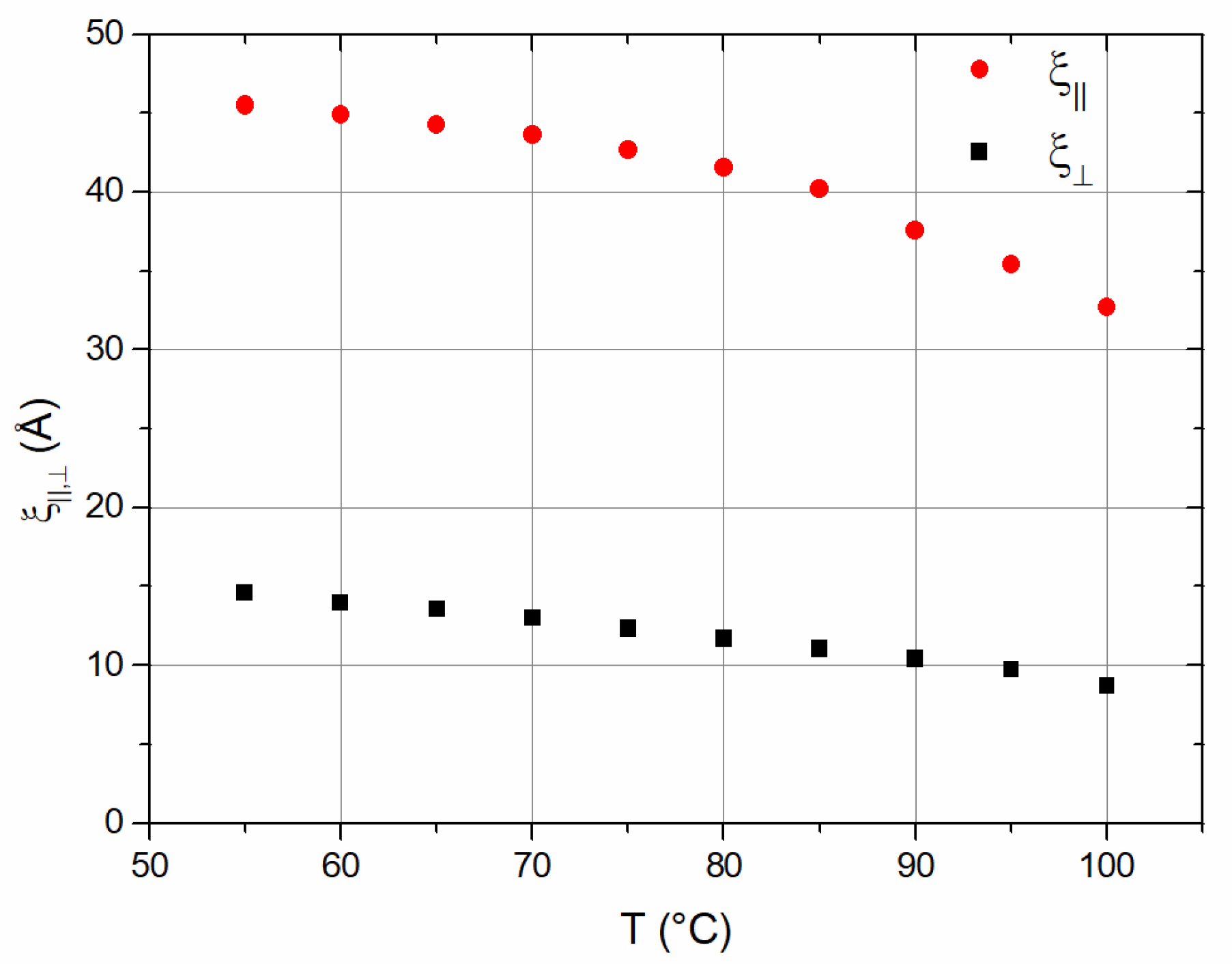
© 2020 by the authors. Licensee MDPI, Basel, Switzerland. This article is an open access article distributed under the terms and conditions of the Creative Commons Attribution (CC BY) license (http://creativecommons.org/licenses/by/4.0/).
Share and Cite
Ghilardi, M.; Adamo, F.C.; Vita, F.; Francescangeli, O.; Domenici, V. Comparative 2H NMR and X-Ray Diffraction Investigation of a Bent-Core Liquid Crystal Showing a Nematic Phase. Crystals 2020, 10, 284. https://doi.org/10.3390/cryst10040284
Ghilardi M, Adamo FC, Vita F, Francescangeli O, Domenici V. Comparative 2H NMR and X-Ray Diffraction Investigation of a Bent-Core Liquid Crystal Showing a Nematic Phase. Crystals. 2020; 10(4):284. https://doi.org/10.3390/cryst10040284
Chicago/Turabian StyleGhilardi, Maria, Fabrizio C. Adamo, Francesco Vita, Oriano Francescangeli, and Valentina Domenici. 2020. "Comparative 2H NMR and X-Ray Diffraction Investigation of a Bent-Core Liquid Crystal Showing a Nematic Phase" Crystals 10, no. 4: 284. https://doi.org/10.3390/cryst10040284
APA StyleGhilardi, M., Adamo, F. C., Vita, F., Francescangeli, O., & Domenici, V. (2020). Comparative 2H NMR and X-Ray Diffraction Investigation of a Bent-Core Liquid Crystal Showing a Nematic Phase. Crystals, 10(4), 284. https://doi.org/10.3390/cryst10040284






